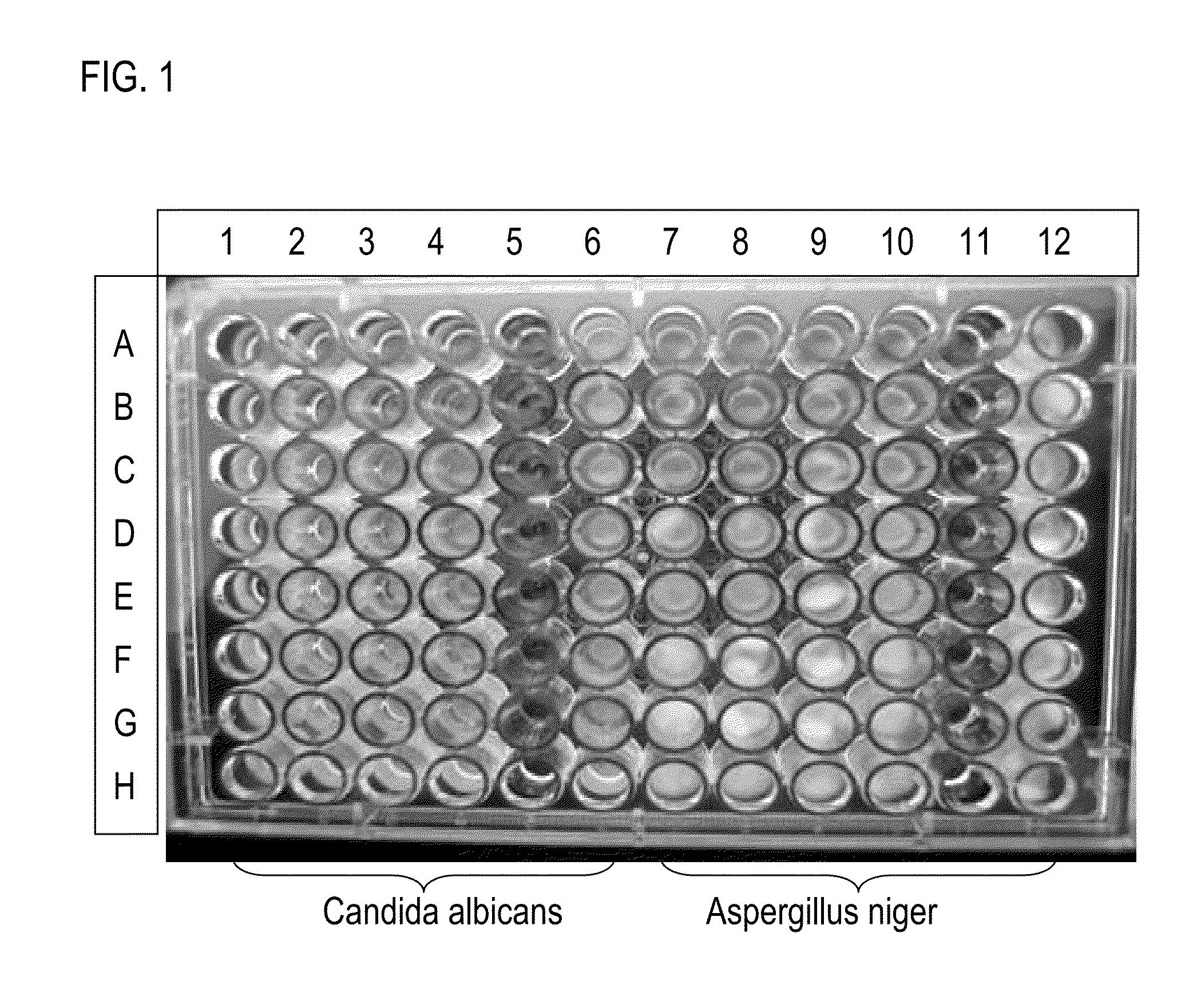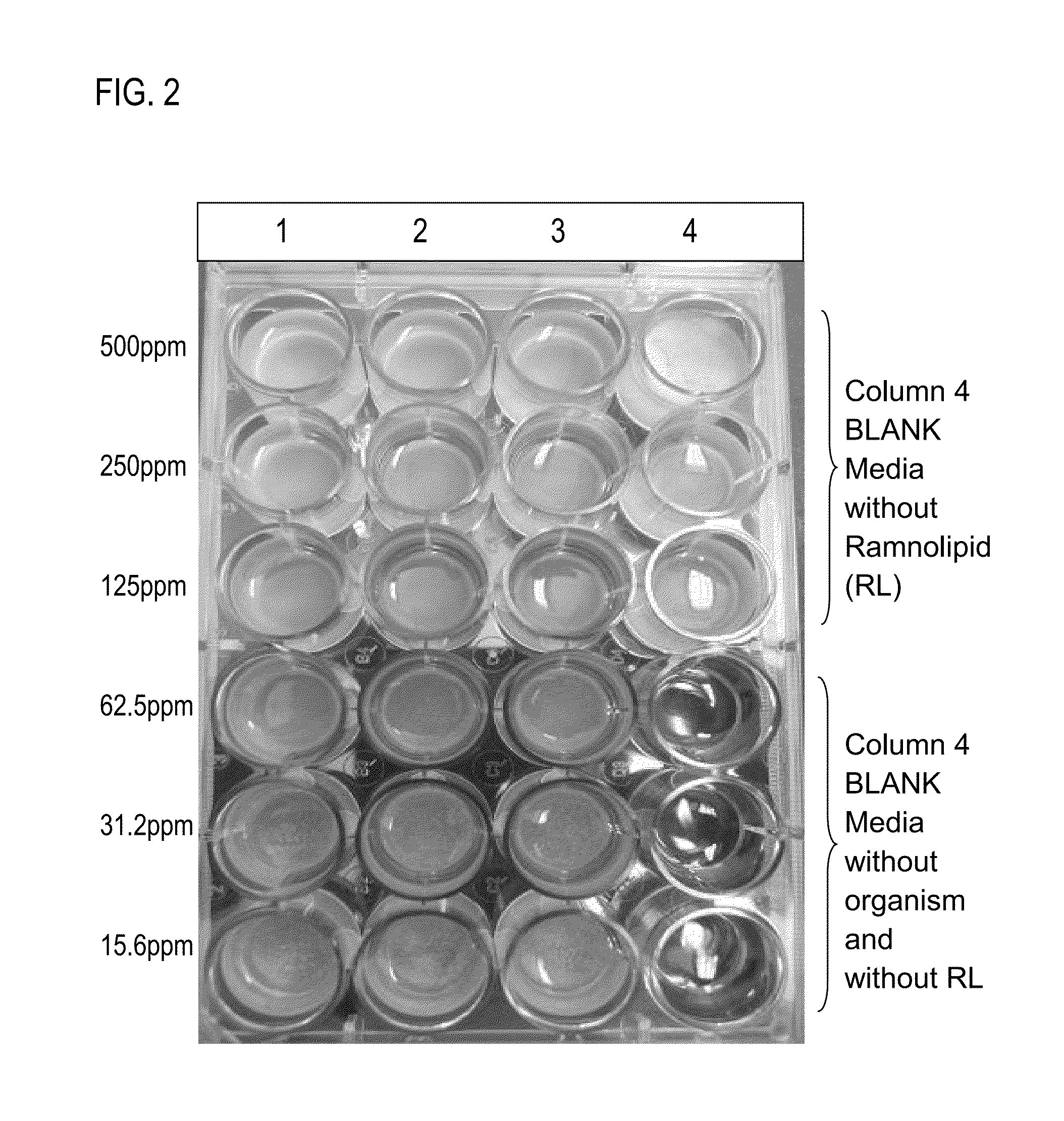Aqueous coatings and paints incorporating one or more antimicrobial biosurfactants and methods for using same
a biosurfactant and antimicrobial technology, applied in the direction of antifouling/underwater paints, coatings, paints containing biocides, etc., can solve the problems of paints or coatings being adversely affected, paints remaining susceptible to softening, degradation by water, etc., and achieve stable monomer pre-emulsion and stable dispersion
- Summary
- Abstract
- Description
- Claims
- Application Information
AI Technical Summary
Benefits of technology
Problems solved by technology
Method used
Image
Examples
example 1
Determination of Rhamnolipid Activity Against Yeast (Candida albicans) and Fungi (Aspergillus niger)
[0237]This example determined the minimum inhibitory concentration (MIC) of Rhamnolipid against Candida albicans and Aspergillus niger.
[0238]FIG. 1 is a photo of the microtiter plate employed in Example 1. The microtiter plate of FIG. 1 is a 96 well plate. In the tested microtiter plate, from left to right, columns 1-6 tested Rhamnolipid with Candida albicans and columns 7-12 tested Rhamnolipid with Aspergillus niger. Rows A-H had varying amounts of Rhamnolipid. A two fold dilutions of Rhamnolipids was made by serially diluting from Row A at 1000 ppm by weight through Row B at 500 ppm, Row C at 250 ppm, Row Dat 125 ppm, Row Eat 62.5 ppm, Row F at 31.3 ppm, Row G at 15.6 ppm and Row H at 7.81 ppm of Rhamnolipid.
[0239]Columns 1-4 had media inoculated with Candida albican, organism and Rhamnolipid. Column 5 was a media blank with no organism and no Rhamnolipid. Column 6 had been inocula...
example 2
Rhamnolipid Activity Against Yeast (Candida albicans)
[0243]Using the same protocol as in Example 1 another MIC determination of Rhamnolipid against Candida albicans was conducted. FIG. 2 shows an expanded view of a portion of a microtiter plate employed for this MIC determination of Rhamnolipid against Candida albicans. From left to right in FIG. 2, columns 1-3 had media, organism and Rhamnolipid. From top to bottom FIG. 4, the tested cells having respective concentrations of 500, 250, 125, 6215, 31.2 and 15.6 ppm Rhamnolipid. Column 4, top three rows, had organism in media with no Rhamnolipid. Column 4 bottom three rows had media with no organism and no Rhamnolipid.
[0244]This shows the effectiveness of Rhamnolipids against Candida albicans.
[0245]FIG. 2 is a photo of the microtiter plate employed in Example 2. The microtiter plate of FIG. 2 is a 24 well microtiter plate. This microtiter plate of FIG. 2 is a larger well plate than shown in FIG. 1. However, it confirms the observatio...
example 3
Activity of CMIT / MIT with and without Rhamnolipids Against Fungus (Aspergillus niger)
[0246]The procedure of Example 1 was repeated to test the activity against fungus (Aspergillus niger) of a CMIT / MIT mixture (Kathon™LX 1.5% available from Dow Chemical) with and without Rhamnolipids.
[0247]FIG. 3 shows a photograph of two 24 well microtiter plates used for this example. From left to right, columns 1-3 employed media, organism and CMIT / MIT alone. Column 4 was a blank with media and organism in the top three rows and media alone in the bottom three rows. Columns 5-7 employed media, organism and CMIT / MIT. Column 8 employed media, Rhamnolipid and no organism in the top three rows and media, Rhamnolipid and organism in the bottom three rows. In the figures ppm means parts per million active by weight. KATHON LX 1.5% is a combination product of CMIT / MIT at 3:1 ratio
[0248]Results show the Minimum Inhibitory Concentration for CMIT / MIT is 1.56 ppm and for combination of CMIT / MIT with 250 ppm ...
PUM
| Property | Measurement | Unit |
|---|---|---|
| wt. % | aaaaa | aaaaa |
| temperature | aaaaa | aaaaa |
| temperature | aaaaa | aaaaa |
Abstract
Description
Claims
Application Information
 Login to View More
Login to View More - R&D
- Intellectual Property
- Life Sciences
- Materials
- Tech Scout
- Unparalleled Data Quality
- Higher Quality Content
- 60% Fewer Hallucinations
Browse by: Latest US Patents, China's latest patents, Technical Efficacy Thesaurus, Application Domain, Technology Topic, Popular Technical Reports.
© 2025 PatSnap. All rights reserved.Legal|Privacy policy|Modern Slavery Act Transparency Statement|Sitemap|About US| Contact US: help@patsnap.com



